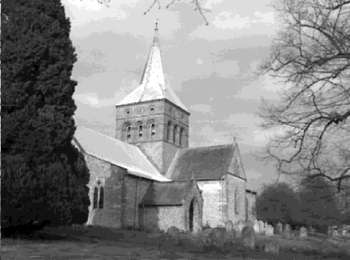![]()

![]()

18. All Saints, East Meon
This early 12th century church must surely be one of the finest in the county. With its massive tower and lead covered spire situated under the lee of Park Hill, it dominates the village with its almost cathedral-like proportions. A real Norman stronghold.
Above the Norman south door as you enter hang the Royal Arms of James I but to the left stands the finest treasure of the church, the famous black Tournai font. Made in Flanders from local marble it was transported to the church in 1150, almost certainly the gift of Henry of Blois the Bishop of Winchester and brother of King Stephen. The bowl is covered in elaborate carvings. The South Face depicts the flat earth with the doves of peace being chased by the dogs of war. The West Face shows the earth surmounted by four mythical beasts with dragon heads. The two remaining faces tell the story of Adam and Eve in graphic detail from their creation in the Garden of Eden until their expulsion by a sword carrying angel. The final scene shows the angel teaching Adam to dig and Eve to spin. Hanging on the wall alongside is a painting of the Entombment of Russian origin seized during the Crimean War.
In the north wall of the nave is an unusual window with two carved fourteenth century heads. Alongside stands a fine eighteenth century pulpit. Looking east all is dominated by the stained glass of the east window erected in 1920 as a memorial to commemorate the First World War. Designed by Sir Ninian Comper it depicts the patron saints and coats of arms of all the Allied Powers. These include St Vladimir of Russia, St Adrian of Rumania, St Methodius of Serbia, St Quintyn of Belgium, St Sebastian of Italy, St Martin of France and so on with the Risen Saviour in the centre. A most unusual and imaginative piece of stained glass. Sir Ninian also designed the altar, the screen of the Lady Chapel as well as the alabaster and wood reredos showing scenes from the life of the Virgin Mary. The Lady Chapel is full of eighteenth century memorials. One of Thomas Benham and his wife Elizabeth is especially noteworthy.
In the South Transept is a stone with the words 'Amens Plenty' carved on it. When taken up from the floor in 1869 four men buried vertically were found below. Legend has it that they were four Parliamentary soldiers killed in the village a few days before the Battle of Cheriton in March 1644. On the wall nearby hangs a water colour of the church c.1800, a description of the church in a magazine of 1819 as well as a list of all vicars since 1283. In the South Aisle is a second font, a very plain stone drum of medieval origin. It came from the ruined chapel of St Nicholas near Westbury House 2½ miles west of the village.
Two modern touches are the 1983 organ standing near the west door and a very fine array of embroidered kneelers. Throughout the eighteenth century and until 1845 the village school of up to 160 children used to meet in the North Transept.
Outside walk round and admire the impressive Norman west door and the massive walls of flint and mortar. Just across the road can be seen the fourteenth century Court House of the Bishops of Winchester. After leaving the church drive south to the high ridge of Winchester Hill and look down for one last glimpse of the spire shining in the distance below. A lovely church in an idyllic setting.
written by John Symonds
![]() Return to the May 1998 Features page
Return to the May 1998 Features page
![]() return to Home page and main index
return to Home page and main index
page last updated 1 MAY 1998